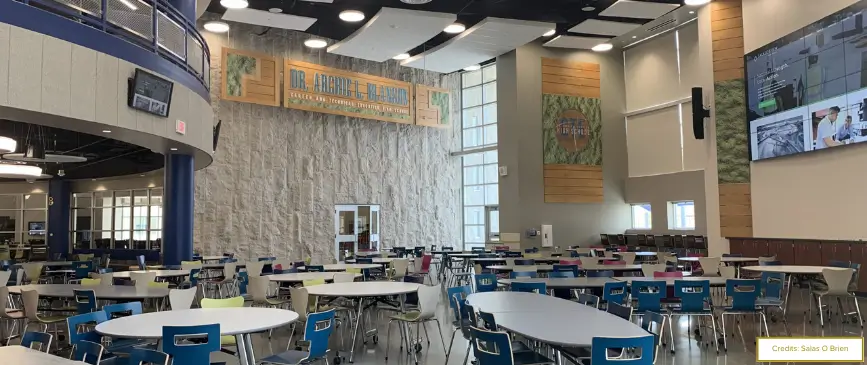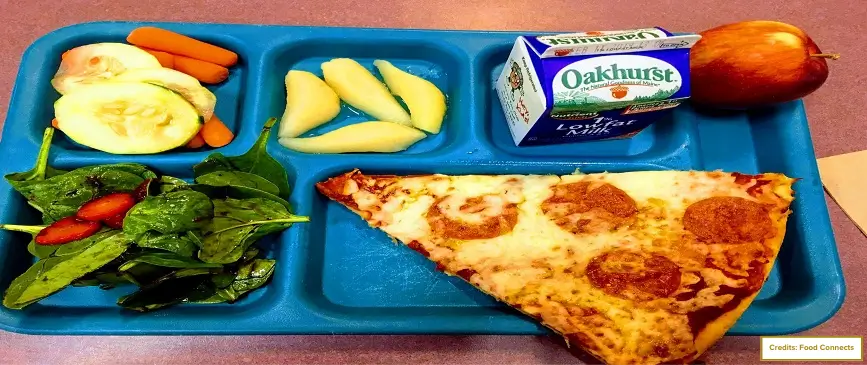Introduction
In the lively debate over school nutrition, the question of whether soda should be offered in school cafeterias sparks strong opinions.
On one hand, kids love the fizzy sweetness of soda, making it an irresistible treat. On the other hand, parents and educators are increasingly concerned about the health impacts of sugary drinks.
Is it fair to deprive students of a beverage they enjoy, or is it a necessary step to safeguard their well-being?
As we delve into this topic, we’ll explore the pros and cons of soda in schools, examining its impacts on student health, academic performance, and overall development.
Join us in this conversation as we navigate the balance between pleasure and responsibility in shaping the dietary habits of our children.

Should Soda Be Offered In School Cafeterias: Yay or Nay?
Let’s begin by addressing the elephant in the room: Is soda bad for kids?
The answer is clear: YES!
With its bubbly allure and sweeteners, Soda poses significant risks, especially for young students. Many children even start this sugary habit early, often because these drinks are so accessible either at home or at school. This soft drink, as a result, causes many health and body issues.
Therefore, it must be kept from being consumed by students. But should soda be banned?

According to studies, experts highlight one culprit: fructose. Unlike other sugars, fructose is found in soda, which fails to trigger the “fullness” hormone, ghrelin, leaving students prone to overeating. One can a day over a year could pack on 55,000 extra calories—enough to tip the scales significantly. But it’s not just the weight gain; fructose causes more hungriness, prompting more soda cravings.
However, thankfully, many schools are now stepping up, reducing soda’s sway on their campuses.
Take the city of Los Angeles, for instance. Water, low-fat juice, and milk now top the beverage menu, signaling a healthier choice for our kids’ futures.
Suggested Reading → Simple Steps for Healthy School Cafeterias.
Soda Offering at School Cafeteria: The Negative Impacts
Sugary beverages (soda) wield a substantial impact on health, linking strongly to obesity, diabetes, and other health issues. The research underscores how frequent consumption heightens risks like heart disease, joint problems, sleep disorders, and diminished self-esteem. For instance, a typical 20-ounce soda packs a staggering load of 18 to 20 teaspoons of sugar and 250 calories.
Studies further reveal that vending machine offerings, rife with these sugary temptations, correlate with higher sugar intake and lower levels of essential nutrients like fiber, vitamins, and iron among children. Hence, medical experts strongly advocate limiting access to these vending machines to promote better health outcomes.

Let’s take a quick look at some of the effects of soda on young minds.
1. Behavioral and Psychological Effects
Children and teens who consume soda regularly are more prone to aggression, depression, and behavioral problems. Studies have linked high soda intake to an increased likelihood of destructive behavior, fights, and even carrying weapons among adolescents.
The research by Injury Prevention, 2011, and the Journal of Pediatrics, 2012 highlights that the more soda consumed by 5-year-olds, the higher the tendency for aggressive actions toward others’ belongings.
2. Nutritional Deficits
Opting for soda over healthier choices like milk can lead to significant nutritional deficiencies, especially in crucial nutrients like calcium, which are essential for bone health. Many children and teenagers, particularly girls, fail to meet the recommended daily intake of calcium, which is vital for preventing conditions like osteoporosis later in life.
Furthermore, excessive soda consumption is linked to a lower intake of essential vitamins and minerals necessary for proper growth and development.
Suggested reading → Why Is Nutritional Education Important For Schools?

3. Caffeine Sensitivity
The caffeine content in soda poses particular risks for children, affecting their sleep patterns, concentration levels, and overall actions. Children are more sensitive to caffeine’s effects, which can result in feelings of restlessness, digestive discomfort, and headaches, all of which can impair their ability to concentrate and perform well academically. Prolonged caffeine consumption in children may also worsen heart and nervous system issues.
4. Health Concerns
Regular consumption of soda is associated with increased risks of obesity, type 2 diabetes, and dental decay due to its high sugar content and acidic nature. The phosphoric acid in soda can weaken bones over time, while sugars and acids contribute to tooth decay, posing severe health risks for students.
5. Academic and Social Impact
A diet high in sugary drinks like soda can negatively impact cognitive function and academic performance, potentially creating an unhealthy school environment.
Soda Offering at School Cafeteria: The Positive Impacts
While this statement may sound surprising, soda could actually benefit students and schools. Despite concerns about its role in obesity, dental health, and mood swings, soda remains incredibly popular, especially among young people aged 12–18, with 6 out of 10 preferring it, according to the American Health Ranking (AHR).

One primary reason is that restricting access can be challenging in today’s world, where sugary drinks are widely available and popular. Allowing controlled access to soda could foster responsible consumption habits while offering students more beverage choices and lunch options during lunchtime.
Another reason for allowing soda in middle school cafeterias is the undeniable appeal of these drinks among students. Cafeterias are not just places to eat but social hubs where students seek enjoyment. Alongside the cafeteria’s graphics, the food offered is a significant draw for students.
Introducing soda machines could cater to students’ preferences and reduce the temptation to seek less nutritious options off-campus. Schools can strike a balance between student desires and nutritional guidelines by offering soda in moderation, perhaps on selected days or in limited quantities.
Here are some pros of including soda in the school cafeteria.
1. Promotion of Choice and Autonomy
Allowing soda in school cafeterias gives students a choice in their dietary preferences. This autonomy can reduce dissatisfaction with cafeteria options, encouraging a more positive student dining experience.
2. Relief and Hydration
Soda can offer relief for minor ailments like stomach aches, nausea, and indigestion. The carbonated water in soda can also aid in hydration and alleviate constipation, providing practical health benefits for students.
3. Financial Support for Schools
The revenue generated from soda sales can be crucial in funding various aspects of school life, including educational programs, extracurricular activities, cafeteria sales, and facility improvements. This income stream helps mitigate budget cuts and ensures vital school initiatives remain supported.

4. Energy Boost and Alertness
The caffeine and sugar content in soda can provide a quick energy boost, helping students stay alert and focused during classes or extracurricular activities.
5. Preparation for Adulthood
Exposing students to various food and beverage choices, including soda, prepares them to make informed decisions about their diets as they transition into adulthood. This early exposure can contribute to lifelong habits of balanced consumption.
Promoting Healthy Choices: Alternatives to Soda in School Cafeterias
At ICC, we believe schools should focus on teaching healthy habits rather than outright banning soda. It’s about empowering students to make informed choices. Instead of just removing options, schools can hold seminars on healthy eating and make lectures more engaging.
Let’s face it: if we want kids to eat healthier, we should rethink what we serve them—less grease and more nutritious meals. Plus, banning soda won’t stop them from finding it elsewhere. Research by the Public Health Organization shows that banning vending machines only slightly reduces soda consumption.
Schools can genuinely make a difference by educating and creating environments that support healthier lifestyles.
Suggested Reading → How To Promote Healthy Eating In School.
Below are some steps that can be taken to foster healthy eating among students.
By School Management
School management can promote healthy eating by offering students a variety of healthy beverage choices, such as water and reduced-sugar beverages. They should also consider stocking smaller-sized containers to help students make portion-controlled choices. Ensuring that water fountains are accessible and in good working condition encourages students to opt for water over sugary alternatives.

By Parents
Parents can play a crucial role by ensuring sugary drinks like soda and fruit punch are not stocked at home, making them occasional treats rather than daily beverages. Parents can also encourage healthier choices by offering water and reduced-sugar options at home.
Additionally, they can advocate for schools to provide filtered water or functioning water fountains, making hydration convenient and promoting water as the beverage of choice during the school day.
By Government Nationals
Government intervention is essential in fostering healthier habits among students. They can mandate better labeling on sugary drinks, making calorie information more prominent and possibly implementing warning labels for high-calorie beverages.
Implementing a soda tax can also discourage the consumption of sugary drinks, similar to approaches used for cigarettes and alcohol. Regulation of marketing aimed at children ensures that unhealthy beverage options are not aggressively promoted, protecting vulnerable populations from excessive exposure to sugary drink advertising.
Soda POP or Soda NOT: The Final Verdict
In conclusion, while the debate over soda in schools continues, it’s worth considering the potential benefits of providing students with more beverage options. It’s not about promoting unhealthy habits but rather acknowledging and accommodating student preferences in a controlled and responsible manner. In doing so, schools can foster a balanced approach to nutrition while teaching students to make informed choices. Educators can support overall well-being by offering healthier alternatives alongside occasional treats like soda without completely restricting students’ choices.
Suggested Reading → 5 Ways to Deliver on Personalized Food Experiences.
FAQs
What are alternatives to soda in school cafeterias?
Alternatives include water, flavored water, milk, and 100% fruit juices. s provide hydration without the added sugars and potential health risks associated with soda.
Does soda consumption affect academic performance?
Yes. Some studies suggest a correlation between high sugar intake, like that from soda, reduced cognitive function, and academic performance in children, impacting their learning outcomes.
What are the health concerns associated with soda consumption among students?
Soda consumption has been linked to an increased risk of obesity, diabetes, and dental cavities due to high sugar content. Health experts often highlight these risks, especially considering the developing bodies of school-age children.
What role can schools play in promoting healthier beverage choices?
Schools can play a decisive role by promoting education about nutrition, offering healthier choices than soda, and creating environments that support healthy eating habits. This includes influencing both cafeteria offerings and vending machine selections.


